Posts Tagged ‘email’
Organizations are working hard to retain employees. Employees are watching how their organization’s leaders and managers work, and often make career decisions based on the hours the most senior people keep. Not a recipe for retaining employees.
Many employees pay particular attention to how often managers and senior leaders take time off and whether or not leaders attend meetings and respond to emails while they’re ‘off.’ Employees observe the late nights that leaders and managers put in and the emails sent at 11:00 pm and on the weekends. I’ve heard lots of employees say, “If I need to work like my boss works to get ahead in this organization, I’m not interested.”
Managers, one of the keys to retaining employees is to communicate expectations. If you’re available while you’re on vacation, but don’t expect employees to do the same, set that expectation. If you send an email outside of regular business hours but don’t expect employees to respond until the next business day, tell them so. They don’t know. Many employees assume that if you email them at night, you expect a reply.
Instead of allowing employees to make assumptions about what managers do and don’t expect, set clear expectations. Be overt and clear. Tell employees, “I work most evenings and weekends, but don’t expect you to do so. And I work these hours because I enjoy it, not because I have to. If I email you outside of regular business hours, I am not expecting you to reply.” Retaining good employees begins during the interview process when initial expectations are set.
Managers, if you expect employees to check and respond to emails outside of regular business hours and to be available while on vacation, tell candidates during the interview process. If working long hours is a criteria for promotion, set that expectation. It’s completely fine to expect long hours and for employees to be accessible outside of regular business hours. There is nothing wrong with either expectation. There is only a problem if employees don’t know that’s the expectation.
Employees, if your manager emails you outside of regular business hours and she doesn’t tell you whether or not she expects you to reply, ask. Simply say, “I often receive emails outside of regular business hours. How will I know when you need me to reply?” Likewise, if you notice your manager emails you on vacation, you can say, “I typically hear from you when you’re on vacation. Are you expecting me to check in while I’m off?”
The need to ask questions and set expectations goes both ways. Don’t wait to be told. Ask.
Managers and employees, ask these Candor Questions about working style preferences to aid in retaining employees:
- How do you feel about being contacted outside of regular business hours?
- If I need to reach you over a weekend or in the evening, what method is best?
- Would you prefer I text you so you don’t have to check your email outside of business hours?
- What time is too early and too late to call, text, and/or email?
Ask more. Assume less and make retaining employees easier.
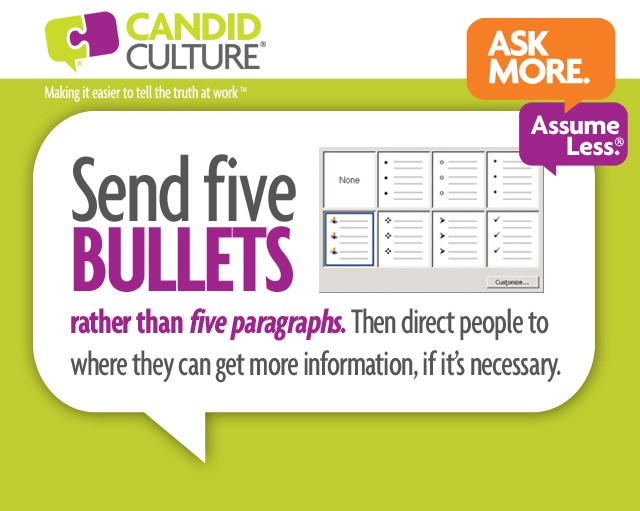 People are drowning in data, more specifically in email. If you want people to read your communications, send short emails and fewer of them.
People are drowning in data, more specifically in email. If you want people to read your communications, send short emails and fewer of them.
How often do you open an email, see its daunting length, close the email promising you’ll get back to it later, but don’t? Then you bump into the sender a week later and he asks, in an annoyed tone, “Did you get my email?” And you attempt to conjure up the email, distinguishing it from the 1,500 emails you’ve received since.
Some people like receiving lots of information, others don’t. Ask your internal and external customers how much information they want to receive, in what format, how frequently, and with how much detail. And when you can, accommodate their preferences.
I’m a big picture person. For me, more information is not necessarily better. I’ll read five bullets. I won’t read five paragraphs. I’m frequently guilty of opening a long email, becoming overwhelmed, deciding I don’t have time to read the entire message, promising to read it later, and by the time I go back to the message, I’ve typically missed a deadline.
You can say it’s my problem that I don’t read long emails, not the sender’s problem. And you’d be right. I should read every email I get in full. But when I don’t give the sender something she needs because I was overwhelmed by the length of her email, it becomes her problem, too. If you want people to respond and do what you’re asking, communicate how they like to communicate whenever possible.
I’d like to say that people are so used to reading short text messages and Facebook and Twitter updates that they’ve been trained not to read anything longer than a few sentences. And there may be something to that. But the truth is, there are detail people who like a lot of data and there are big picture people who don’t. If you provide a high level summary – just what recipients need to know – followed by more details or information on where more details can be found, you accommodate both the detail and the big picture people.
When you write your next email or any other type of communication, consider: Could this be said with fewer words? Do the recipients want or need this level of detail? Then, shorten your communications and accommodate both the big picture and the detail people. And you’ll be amazed at how quickly you receive the things you’re asking for.
And if that’s not working, go old school and use our greeting cards to write a note, because no one can resist a handwritten note.

Reading emails as they come in is killing your productivity.
You’re at your desk working on a project. Aka, doing actual work. You think, “It’s been three minutes. I should check my email.” So you take your attention off your project and check your email. Then you read the five emails that came in since you last checked email. You then go back to the project you were working on and spend 10 to 20 minutes trying to get your head around what you were doing before reading those very important emails. Finally, you’re back in the groove. You do five minutes of work and think, “I should check my email.” Then it’s 5:30 pm and you realize, with frustration, that you finished nothing all day.
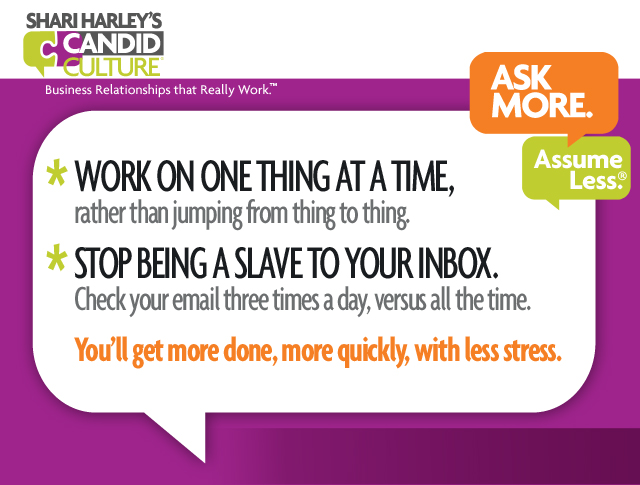 Sound familiar?
Sound familiar?
Living in our email inbox is why many of us start work at 5:00 pm or come into the office at 7:00 am to get “something done while it’s quiet.” It’s why we sleep and go on vacation with our phones, and are never really off.
I am most productive on airplanes without WIFI. Without WIFI I’m not tempted to check my email every three minutes or check Facebook to read about what people I barely know and don’t really care about are doing.
Without WIFI all there is to do is what I need to do. There are no other meaningful distractions, except for the B-grade movie I didn’t really want to see anyway. I am focused. And as a result, I get a lot done. I’m also less stressed. Because I’m focused, doing one thing a time, I’m not worried about everything I still need to do.
If you want to get more done and be less stressed, do one thing at a time, for a defined period of time. Decide how long you’re going to work on something, and work on that item for that period of time, with no distractions or interruptions. You may only work on something for ten or twenty minutes, but do only what you said you would do for that time period. Then you can check your email.
Productivity experts suggest you only check your email three times a day, for example, once in the morning, right before or after lunch, and at the end of the day. I find this hard to do. Like you, I feel pressured to check my inbox. Or I use my email to avoid the work I really need to do. But I know that constantly being in my email inbox has me distracted and not doing the work I really need to do. And as a result, I’m stressed and spend my evenings and weekends working on projects that require focused time.
Do one thing at a time, for a defined period of time. Just try it. If you’re going to read your email, give yourself 20 minutes, and do nothing but read, reply, and delete email. At the end of 20 minutes, do whatever you said you would do next, for as long as you decide, and nothing else.
See if you get more done, in less time, with less stress. You might just leave work earlier and have time to do something besides work.

Organizations are working hard at retaining employees. Employees are watching how their organization’s leaders and managers work, and often make career decisions based on the hours the most senior people keep. Not a recipe for retaining employees.
Many employees pay particular attention to how often managers and senior leaders take vacations and whether or not leaders attend meetings and respond to emails while they’re ‘off.’ Employees observe the late nights leaders and managers put in and the emails sent at 11:00 pm and on the weekends. I’ve heard lots of employees say, “If I need to work like my boss works to get ahead in this organization, I’m not interested.”
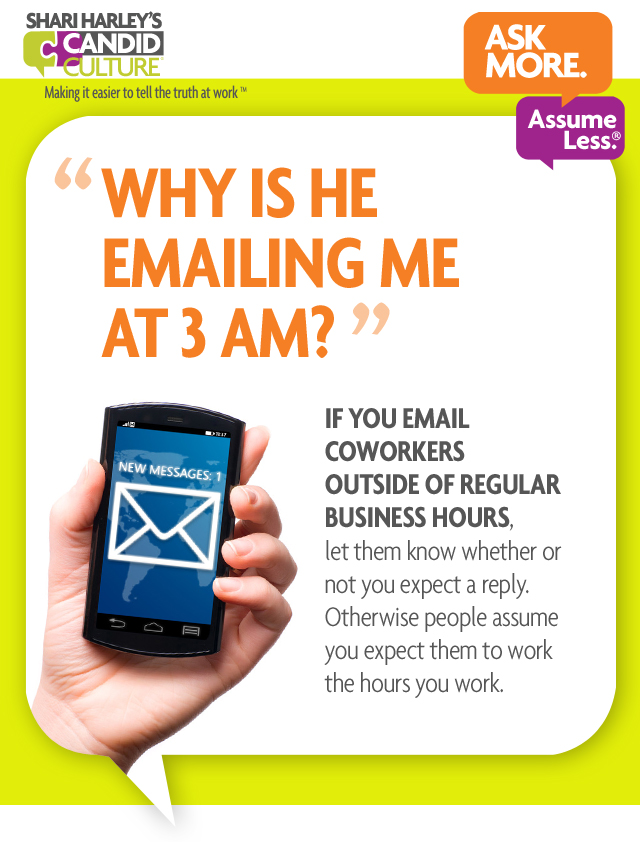
Managers, the key to retaining employees is to communicate expectations. If you’re available while you’re on vacation, but don’t expect your employees to do the same, set that expectation. If you send an email outside of regular business hours but don’t expect employees to respond until the next business day, tell them so. They don’t know. Many employees assume that if you email them at night, you expect a reply.
Instead of allowing employees to make assumptions about what managers do and don’t expect, set clear expectations. Be overt and clear. Tell employees, “I work most evenings and weekends, but don’t expect you to do so. And I work these hours because I enjoy it, not because I have to. If I email you outside of regular business hours, I am not expecting you to reply.” Retaining good employees begins during the interview process, when initial expectations are first set.
Managers, if you expect employees to check and respond to emails outside of regular business hours and to be available while on vacation, tell them. If working long hours is a criteria for promotion, set that expectation preferably during the interview process. It’s completely fine to expect long hours and for employees to be accessible outside of regular business hours. There is nothing wrong with either expectation. There is only a problem if employees don’t know that’s the expectation.
Employees, if your manager emails you outside of regular business hours and she doesn’t tell you whether or not she expects you to reply, ask. Simply say, “I often receive emails outside of regular business hours. How will I know when you need me to reply?” Likewise, if you notice your manager emails you on vacation, you can say, “I typically hear from you when you’re on vacation. Are you expecting me to check in while I’m off?”
The need to ask questions and set expectations goes both ways. Don’t wait to be told. Ask.
Managers and employees, ask these Candor Questions about working style preferences to aid in retaining employees:
- How do you feel about being contacted outside of regular business hours?
- If I need to reach you over a weekend or in the evening, what method is best?
- Would you prefer I text you so you don’t have to check your email outside of business hours?
- What time is too early and too late to call, text, and/or email?
Ask more. Assume less and make retaining employees easier.
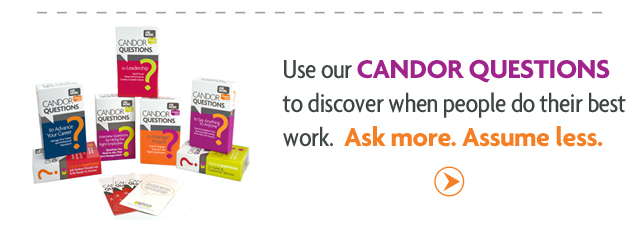
Organizations are working hard at retaining employees. Employees are watching how their organization’s leaders and managers work, and often make career decisions based on the hours the most senior people keep. Not a recipe for retaining employees.
Many employees pay particular attention to how often managers and senior leaders take vacations and whether or not leaders attend meetings and respond to emails while they’re ‘off.’ Employees observe the late nights leaders and managers put in and the emails sent at 11:00 pm and on the weekends. I’ve heard lots of employees say, “If I need to work like my boss works to get ahead in this organization, I’m not interested.”

Managers, the key to retaining employees is to communicate expectations. If you’re available while you’re on vacation, but don’t expect your employees to do the same, set that expectation. If you send an email outside of regular business hours but don’t expect employees to respond until the next business day, tell them so. They don’t know. Many employees assume that if you email them at night, you expect a reply.
Instead of allowing employees to make assumptions about what managers do and don’t expect, set clear expectations. Be overt and clear. Tell employees, “I work most evenings and weekends, but don’t expect you to do so. And I work these hours because I enjoy it, not because I have to. If I email you outside of regular business hours, I am not expecting you to reply.” Retaining good employees begins during the interview process, when initial expectations are first set.
Managers, if you expect employees to check and respond to emails outside of regular business hours and to be available while on vacation, tell them. If working long hours is a criteria for promotion, set that expectation preferably during the interview process. It’s completely fine to expect long hours and for employees to be accessible outside of regular business hours. There is nothing wrong with either expectation. There is only a problem if employees don’t know that’s the expectation.
Employees, if your manager emails you outside of regular business hours and she doesn’t tell you whether or not she expects you to reply, ask. Simply say, “I often receive emails outside of regular business hours. How will I know when you need me to reply?” Likewise, if you notice your manager emails you on vacation, you can say, “I typically hear from you when you’re on vacation. Are you expecting me to check in while I’m off?”
The need to ask questions and set expectations goes both ways. Don’t wait to be told. Ask.
Managers and employees, ask these Candor Questions about working style preferences to aid in retaining employees:
- How do you feel about being contacted outside of regular business hours?
- If I need to reach you over a weekend or in the evening, what method is best?
- Would you prefer I text you so you don’t have to check your email outside of business hours?
- What time is too early and too late to call, text, and/or email?
Ask more. Assume less and make retaining employees easier.

 People are drowning in data, more specifically in email. If you want people to read your communications, send short emails and fewer of them.
People are drowning in data, more specifically in email. If you want people to read your communications, send short emails and fewer of them.
How often do you open an email, see its daunting length, close the email promising you’ll get back to it later, but don’t. Then you bump into the sender a week later and he asks, in an annoyed tone, “Did you get my email?” And you attempt to conjure up the email, distinguishing it from the 1500 you’ve received since.
Some people like receiving lots of information, others don’t. Ask your internal and external customers how much information they want to receive, in what format, how frequently, and with how much detail. And when you can, accommodate their preferences.
I’m a big picture person. For me, more information is not necessarily better. I’ll read five bullets. I won’t read five paragraphs. I’m frequently guilty of opening a long email, becoming overwhelmed, deciding I don’t have time to read the entire message, promising to read it later, and by the time I go back to the message, I’ve typically missed a deadline.
You can say it’s my problem that I don’t read long emails, not the sender’s problem. And you’d be right. I should read every email I get in full. But when I don’t give the sender something she needs, because I was overwhelmed by the length of her email, it becomes her problem too. If you want people to respond and do what you’re asking, communicate how they like to communicate, whenever possible.
I’d like to say that people are so used to reading short text messages and Facebook and Twitter updates that they’ve been trained not to read anything longer than a few sentences. And there may be something to that. But the truth, is there are detail people who like a lot of data and there are big picture people who don’t. If you provide a high level summary – just what recipients need to know – followed by more details or information on where more details can be found, you accommodate both the detail and the big picture people.
When you write your next email or any other type of communication, consider, could this be said with fewer words? Do the recipients want or need this level of detail? Then, shorten your communications and accommodate both the big picture and the detail people. And you’ll be amazed at how quickly you receive the things you’re asking for.
And if that’s not working, go old school and use our greeting cards to write a note, because no one can resist and handwritten note.

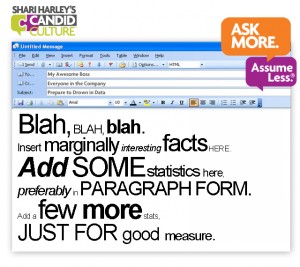 When I get an email that has multiple paragraphs I look at it, decide I don’t have time to read it, and close it out, promising to go back to it later when I have more time, which never happens. Sorry if you’re the recipient of this practice. I’m sure there are several people reading this who have given up on the idea of my responding.
When I get an email that has multiple paragraphs I look at it, decide I don’t have time to read it, and close it out, promising to go back to it later when I have more time, which never happens. Sorry if you’re the recipient of this practice. I’m sure there are several people reading this who have given up on the idea of my responding.
Here are a few tips for writing effective emails that more likely to be read:
- Put a specific subject in the subject line that says what the email is about.
- This does not include your name. We already know your name.
- Ex.: “Trip” (that’s not specific). Instead try: “Trip to Arkansas to see Walmart”
- Highlight and bold important parts of the email
- Limit this practice so what’s bolded and highlighted stands out.
- If everything is bold, nothing stands out.
- Use bullets
- Use the fewest number of words possible
- Use jump links that send readers to relevant information
- Offer additional information if desired
If you read my blog regularly, you’ll notice bold important sentences and use bulleted and numbered lists to make the blog easier to read, like the list above.
The shorter your emails are, the more likely they are to get read. You can always offer additional information, but readers won’t get to the detail if they never read the email. When it comes to writing effective emails, shorter is better.
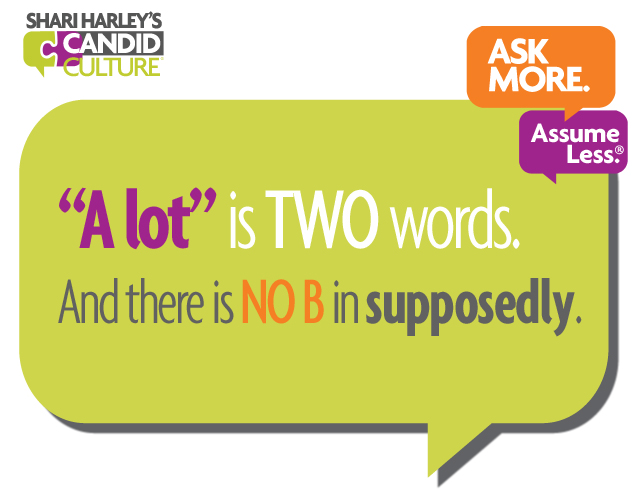 A few weeks ago I received an email from a candidate for a job I recently filled. His grammar, in the email, wasn’t great. The job requires writing, so I asked for a writing sample. The writing sample I received was riddled with spelling and grammar errors.
A few weeks ago I received an email from a candidate for a job I recently filled. His grammar, in the email, wasn’t great. The job requires writing, so I asked for a writing sample. The writing sample I received was riddled with spelling and grammar errors.
When I rejected the candidate, because of his bad grammar and spelling, some of my friends defended the candidate saying that spelling didn’t predict how successful someone would be and that poor writing is incredibly common in this country.
Their comments reminded me of the graduate level leadership class I taught a few years ago. Many of my master’s level students’ grammar was so poor, when I handed back my students’ first papers, I gave them a grammar lesson. Some class members were so offended and annoyed by this, they reported me to the dean, telling her that they did not pay $1500 for a grammar lesson. My stand remains the same.
I don’t care how great a leader you are. If you discredit yourself in every email you send by using bad grammar, your career will be limited.
Here are some common examples of bad grammar in both written and spoken communication:
- “A lot” is two words.
- Incentify is not a word. Incent is.
- Too means also. To does not.
- There is no B in supposedly.
- Your crazy aunt can only visit once a year without you wanting to change your address, and this does not mean that you’re a bad person.
- You accept advice. You advise others.
- There is no X in especially.
- You lose your marbles when you don’t get enough sleep. Your jeans become loose when you stop eating Snickers bars.
- You accept advice, except when you think the other person isn’t the sharpest tool in the shed.
- Irregardless is not a word. Regardless is.
- “Where you at?” “Where are you,” will do.
- Please put your contact information on the bottom of your initial and reply emails. This is not a grammar thing, it would just be helpful.
Call me picky or old school. But I suspect that when you hear these errors made in conversation or see them in writing, you judge the other person. I know most hiring managers do. Hiring managers want to know employees can write reports and email clients without embarrassing the company.
You will be eliminated as a job candidate if your resume has typos. People will judge you when you use incorrect English. They won’t tell you they’re judging your bad grammar. They’ll do it quietly or talk about you when you’re not there.
I spoke at a conference a few weeks ago where an attendee asked how to tell an employee she was going to be fired because her writing was so poor. She maintained client files and wrote client correspondence. Clients’ names were often wrong, in her written notes, as was spelling and grammar. The typos and grammar errors were a deal breaker. And they may be in your job as well.
Have someone proofread a few of your emails and reports, and ask for feedback on your writing. Ask the coworkers you’re close to to tell you when you make grammar errors in meetings. Of course you want them to tell you privately, after the meeting.
I write a bi-monthly column for the Denver Business Journal. I’m grateful that my editor reads this blog and emails me the typos and errors I make. I am not exempt.
Clean up your bad grammar and your writing, and accelerate your career. I promise it will work.
Reading emails as they come in is killing your productivity.
You’re at your desk working on a project. Aka, doing actual work. You think, “It’s been three minutes. I should check my email.” So you take your attention off your project and check your email. Then you read the next two emails that come in and check your voicemail. You then go back to the project you were working on and spend 10 to 20 minutes trying to get your head around what you were doing before reading all of those very important emails. Finally, you’re back in the groove. You do five minutes of work and think, “I should check my email.” Then it’s 5:30 pm and you realize, with frustration, that you finished nothing all day.
 Sound familiar?
Sound familiar?
Living in our email inbox is why many of us start work at 5:00 pm or come into the office at 7:00 am to get “something done while it’s quiet.” It’s why we sleep and go on vacation with our phones, and are never really off.
I am most productive on airplanes without WIFI. Without WIFI I’m not tempted to check my email every three minutes or check Facebook to read about what people I barely know and don’t really care about are doing.
Without WIFI all there is to do is what I need to do. There are no other meaningful distractions, except for the B-grade movie I didn’t really want to see anyway. I am focused. And as a result, I get a lot done. I’m also less stressed. Because I’m focused, doing one thing a time, I’m not worried about everything I still need to do.
If you want to get more done and be less stressed, do one thing at a time, for a defined period of time. Decide how long you’re going to work on something, and work on that item for that period of time, with no distractions or interruptions. You may only work on something for ten or twenty minutes, but do only what you said you would do for that time period. Then you can check your email.
Productivity experts suggest you only check your email three times a day, for example, once in the morning, right before or after lunch, and at the end of the day. I find this hard to do. Like you, I feel pressured to check my inbox. Or I use my email to avoid the work I really need to do. But I know that constantly being in my email inbox has me distracted and not doing the work I really need to do. And as a result, I’m stressed and spend my evenings and weekends working on projects that require focused time.
Do one thing at a time, for a defined period of time. Just try it. If you’re going to read your email, give yourself 20 minutes, and do nothing but read, reply, and delete email. At the end of 20 minutes, do whatever you said you would do next, for as long as you decide, and nothing else.
See if you get more done, in less time, with less stress. You might just leave work earlier and have time to do something besides work.
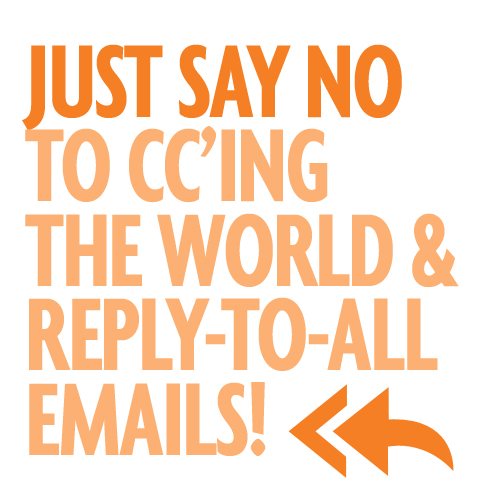
You need something from Suzanne. Suzanne tends to ignore your emails. So in frustration, when sending Suzanne requests, you begin Cc’ing your boss and Suzanne’s boss. This has happened to most of us.
People Cc people who don’t really need to receive communications for a few reasons:
1) Sometimes people really aren’t sure who needs to know the information. So just to be safe, they include others. This can be quite innocent.
2) Sometimes people want others to know what they’re up to (a.k.a. they’re seeking recognition). This is not necessarily bad. It’s important to share what you’re doing for the organization, and cc’ing ancillary people on emails can be a very smart thing to do.
3) Lastly, sometimes people are afraid they won’t get what they need from the email recipient, so they Cc lots of people. This is typically not so innocent.
What should you do when someone Cc’s the world when emailing you, and you fear that it makes you look bad?

I suggest speaking directly with people who Cc others on emails. The conversation could sound something like this, “I noticed that when you email me you have a tendency to Cc other department heads. For example, last week when you asked me for the year-end numbers, you Cc’d my boss, Lisa in Marketing, and Bob in Sales. I was wondering why you’re doing that?”
Then stop talking and listen to what the person says.
Depending on what s/he says, you can respond with something like, “I will always strive to provide you with what you need. If you don’t get what you need from me in a timely way, by all means escalate your request, and go to the people above me. But I’d really appreciate if you’d come to me first and give me a chance to fulfill your request. Would you be willing to do that?”
If the person says something like, “I just think Lisa and Bob need to have this information. I have no other agenda,” you can respond with something like, “I don’t think they need this information, but why don’t we ask them. Would you be comfortable with that? I’ll send them both a message and Cc you, letting them know we talked about this email chain, and ask if they want to continue to receive the messages. How does that sound?”
You never know why someone is doing something, even if you think you know. Ask!
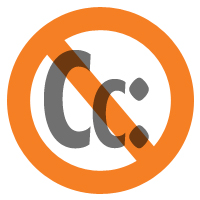
I encourage you to say something versus nothing. If you say nothing you’ll likely make decisions about the person and about your working relationship that may or may not be accurate. If you say nothing, the behavior is bound to continue.
People change their behavior for two reasons, positive and negative consequences. No consequences, no behavior change. No one likes to be ‘called on’ their behavior. Often a conversation like the one above will make the person uncomfortable enough to stop doing what they’re doing.
Reply All Etiquette:
More innocent than Cc’ing the world, but equally annoying, is the reply-to-all email. Someone in your office sends around a joke. Seventy-five people feel compelled to reply to all with their feelings about the joke. When I see things like this, I count how much money in lost wages companies are spending, that is, after I’ve put a pen in my eye.
To prevent reply to all emails, the person who initiates the first email can put in LARGE FONT, “Please reply only to me!”
You can also bcc people on the initial email so the reply’s don’t go to everyone.
It also takes only one person who asks people to stop replying to all, for the email chain to stop. And it’s perfectly appropriate to do this. The email could sound something like, “Going forward, please only reply to Brian, versus replying to all. Thank you!”
When things in the workplace frustrate you, it can be easier to say nothing than to say something. Saying nothing will also help nothing. The frustration is still there. The relationships are still damaged. Gather your courage, and save your office mates a lot of time.




 People are drowning in data, more specifically in email. If you want people to read your communications, send short emails and fewer of them.
People are drowning in data, more specifically in email. If you want people to read your communications, send short emails and fewer of them.
 Sound familiar?
Sound familiar?
 People are drowning in data, more specifically in email. If you want people to read your communications, send short emails and fewer of them.
People are drowning in data, more specifically in email. If you want people to read your communications, send short emails and fewer of them.
 When I get an email that has multiple paragraphs I look at it, decide I don’t have time to read it, and close it out, promising to go back to it later when I have more time, which never happens. Sorry if you’re the recipient of this practice. I’m sure there are several people reading this who have given up on the idea of my responding.
When I get an email that has multiple paragraphs I look at it, decide I don’t have time to read it, and close it out, promising to go back to it later when I have more time, which never happens. Sorry if you’re the recipient of this practice. I’m sure there are several people reading this who have given up on the idea of my responding. A few weeks ago I received an email from a candidate for a job I recently filled. His grammar, in the email, wasn’t great. The job requires writing, so I asked for a writing sample. The writing sample I received was riddled with spelling and grammar errors.
A few weeks ago I received an email from a candidate for a job I recently filled. His grammar, in the email, wasn’t great. The job requires writing, so I asked for a writing sample. The writing sample I received was riddled with spelling and grammar errors.


